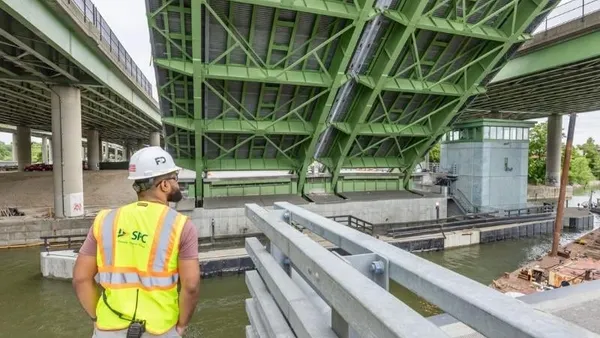The next new thing in the construction industry, be it a project delivery method or the latest technology, always garners a lot of attention, even from those that might not ever use it.
This is probably the reason that while most contractors have never been part of a public-private partnership (P3) team, they definitely watch those who are. So, the exit during the last few years of some major players from the P3 equity partnership market was big news.
Construction heavy hitters including Skanska, Granite and Fluor announced their intention to forego investment in P3s, although not their potential participation as contractors.
Last year, Richard Kennedy, president of Skanska USA, told Construction Dive that a past glut of competitors in the space had caused owners to push tighter schedules and had forced fees down "which pushed risk and reward out of bounds."
During the Design-Build Institute of America's virtual conference last wee, a panel of experts offered a glimpse into the kinds of challenges design-build contractors on major transportation projects face and suggestions about what could make relationships between the private and public sectors more equitable.
The withdrawal of some large companies from the P3 market, said Steven Dewitt, senior vice president for business development at ACS Infrastructure Development, has proven to be a hindrance to optimizing the transfer of risk and ensuring adequate market participation, which provides the best value for owners.
"The results of that are owners may not have the same competition that they would like and really need on these kinds of projects," he said.
Dewitt, who has decades of experience with transportation projects both on the public and private sides, said the "bucket of risks" that design-build contractors face on P3 projects include:
- Lack of project readiness.
- Changes in political support for some projects.
- Unreasonable delays in solving project issues, including disputes.
- Launching projects without a solid financial plan or adequate funding mechanisms.
- Contractual transfer of difficult or insurmountable technical risks to the private sector.
Identifying, allocating risk
Thomas Sherman, deputy director of the Virginia Department of Transportation's Office of Public-Private Partnerships, said his department, in pursuit of the most competitive procurements possible, has spent a lot of time trying to better understand risk and allocating it to the best party prepared to handle it, even if that means VDOT assuming some of the risk.
For example, Sherman said, VDOT has been trying to mitigate some risk around utility projects by using its influence and resources in helping to secure the necessary permits, which can be a challenging process.
Joe Wingerter, vice president of project development at Kiewit, said the evolution of P3s has brought with it "unbalanced expectations about risk transfer, with some team members focusing on the investment side and figuring that the design and construction portions of the projects would just "fall into place."
But, he said, now is the time to look to the future of P3s and use tools like data analytics, integrated project delivery innovations and collaboration in order to achieve solution-oriented outcomes.
A lack of imagination and foresight, said attorney Adam Giuliano with the law firm of Kaplan Kirsch & Rockwell LLP, as well as a failure to communicate effectively about issues of risk, are evidenced by things like faulty bid pricing, misallocated contract risk and a scope of work that is lacking or incorrect in some way.
Ultimately, Dewiit said, each participant needs to try to better understand the other's perspective.
“Sometimes those things are changeable, sometimes they're not,” he said, “and we just need to help understand the other guys, if you will, and find solutions … to help us maybe get a better process in place that helps us move forward.”
Best practices
However, better communication, Wingerter said, could be impeded by a number of factors including the way the team — developer, owner, contractor — is set up. Each member is likely to have its own project concerns and priorities, but the resulting structural silos can create barriers that sometimes end up cutting the design-builder out of important conversations.
“So we would educate [the owners and] talk to them … about the range of outcomes they could have and … best practices to ensure their best outcomes going forward,” Giuliano said. “We really think that the collaboration approach is one of the best.”
No one on the panel suggested that P3s will be risk-free for contractors or any other member of the team.
“We as an industry aren't trying to say 'don't give us any risk,” Dewitt said. “That's not the message here. The message here is we want to make sure that the risk transfer is appropriate.”





















